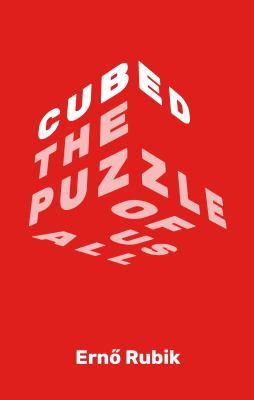
Cubed : the puzzle of us all
The first book by the reclusive inventor of the world's most iconic puzzle THE RUBIK'S CUBE. Erno Rubik inspires us with what he's learned in a lifetime of creating, curiosity, and discovery. ERNO RUBIK was a child when he first became obsessed with puzzles of all kinds. "Puzzles," he writes, "bring out important qualities in each of us: concentration, curiosity, a sense of play, the eagerness to discover a solution." To Rubik puzzles aren't just games-they're creativity machines. He encourages us to embrace our inner curiosity and find the puzzles that surround us in our everyday lives. "If you are determined, you will solve them," he writes. Rubik's own puzzle, the Cube, went on to be solved by millions worldwide for over forty years, become one of the bestselling toys of all time, and to be featured as a global symbol of intelligence and ingenuity. In Cubed, Rubik covers more than just his journey to inventing his eponymous cube. He makes a case for always being an amateur-something he has always which considered himself. He discusses the inevitability of problems during any act of invention. He reveals what it was like to experience the astonishing worldwide success of an object he made purely for his own play. And he offers what he thinks it means to be a true creator (hint: anyone can do it). Steeped in the wisdom and also the humility of a born inventor, Cubed offers a unique look at the imperfect science of creation
Available Copies by Location
| Location | |
|---|---|
| Stamford | Available |
Browse Related Items
| Subject |
| Rubik, Ernő. Rubik's Cube. Inventors > Hungary > Biography. |
| Genre |
| Biographies. |
- ISBN: 9781250217776
- Physical Description 208 pages ; 22 cm
- Edition First edition.
- Publisher [Place of publication not identified] : [publisher not identified], 2020.
Additional Information

Publishers Weekly Review
Cubed : The Puzzle of Us All
Publishers Weekly
(c) Copyright PWxyz, LLC. All rights reserved
Hungarian architect and entrepreneur Rubik delivers a quirky memoir of a man and his eponymous creation. The narrative begins in 1974, when 30-year-old Rubik is building "Cube" prototypes with wood, rubber bands, and fishing line. Describing his memoir as a "meta" work, echoing the chaotic cube-solving experience itself, he reflects on the joys and challenges of design in general, and his eventual achievement, the Rubik's Cube: "Its core is like that of the earth's, we're drawn to it by gravity," he writes. And as the Cube's success proves, "in the rare cases when the harmony of function and design miraculously come together, beauty is achieved." One hundred million of them were sold worldwide within three years of its 1980 release, a level of popularity that Rubik attributes to the fact that it's "a puzzle that needs no instruction manuals or elaborate rules." After recounting the Cube's many pop culture appearances in media and the emergence of Rubik's Cube competitions, Rubik takes readers on a series of digressions, including one on the "unknowable mysteries of the cube." It's a clever concept, but the narrative rambles. Despite his otherwise charming and humble delivery, the book may not keep the casual reader engaged, though puzzle enthusiasts and design students will find plenty of takeaways. (Sept.)

Kirkus Review
Cubed : The Puzzle of Us All
Kirkus Reviews
Copyright (c) Kirkus Reviews, used with permission.
The Hungarian inventor of the Rubik's Cube cheerfully recounts its history as well as his own. "I hate to write," admits Rubik (b. 1944) early on, and what he's written here is far from a conventional memoir. Readers will glean some of the basic facts of the author's biography, at least up until the point in the narrative about his hiring as a professor of design and architecture. He only provides glimpses of his wife and kids, but he lovingly details the houses he has designed and occupied. The Budapest native was raised by a stern engineer father "obsessed with creating the perfect glider" and a sweet, poetically inclined mother. Though school "was not able to capture [his] attention," he did like drawing and figuring out puzzles. His best-known invention was conceived in his spare time in 1974, and the most fascinating sections of the book describe the various challenges he faced and surmounted in creating the object he considers "my boy, my son" as well as the problems he had in solving the puzzle after it was created. (Those who have been stumped by it will be happy to learn that it took Rubik a month to figure out how to get the pieces back into their original pattern.) As the creator of the puzzle, he has some intriguing insights about what has made it so enduringly popular, suggesting that it creates "a harmony in the mind, the heart, and the hands" and invites the player to "start a dialogue with it." Reflecting on the particulars of his life often leads him on long, sometimes generic tangents about more abstract subjects, such as creativity, curiosity, the "art of asking questions," and artificial intelligence. But he always pulls the story back to his namesake. A playful examination of the process of invention. Copyright (c) Kirkus Reviews, used with permission.


